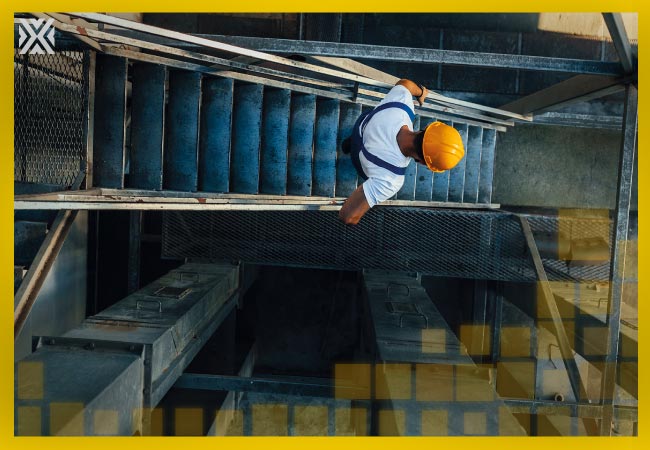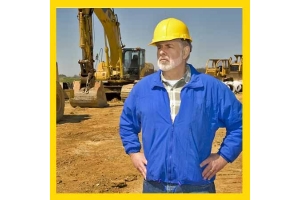Currency
June 03, 2022

Head protection is one of the most critical elements of personal protective equipment. This is because our heads are delicate and vulnerable and can be easily damaged. Of course, one of our most important organs, our brain, is also contained within our skulls. As with all aspects of health and safety, a proper risk assessment must be conducted first to establish if there is any risk of head injury from the work or task that you are about to engage in.
Again, as with all aspects of health and safety, if there is a risk of head injury then you have to apply the hierarchy of controls to determine the most appropriate protective measures to take. This would involve trying to eliminate the hazard if at all possible. An example might be that if you had a construction activity where there was a risk of dropped objects striking someone on the head, then one way to try and eliminate the hazard may be to separate the people from the risk. This might involve barricading off the area to prevent people from coming into contact with the overhead materials. If this is not possible another option may be to construct a protective “tunnel” for passers-by, such that any materials that fall will land on the roof of the tunnel. This is the approach generally taken by construction activities on public shopping areas where it is not practicable to barricade off access to the shops and, of course, it is not feasible to ask all members of the public to wear a protective helmet.
In many cases we do try to take preventative and administrative controls, but often there is still some residual risk of head injury which we have to try and manage. This invariably comes down to the provision of personal protective equipment. With head protection this is generically known as a “hard hat”. But, it should be recognised that not all “hard hats” are the same. The piece of head protection that most of us are probably more familiar with is a cycling helmet, designed to protect our heads if we fall off our bicycles.
Cycling helmets are fitted with ventilation areas to make them more comfortable, they often have an aerodynamic design. I have often been asked why construction helmets aren’t also fitted with ventilation spaces to make them more comfortable, and of course the reason is that these two types of head gear are designed to protect us from different hazards. The construction helmet aims to protect us from dropped or falling objects, including sharp objects like hand tools, and materials like glass. So, it would not be practicable to have ventilation strips in this type of helmet as sharp objects could pass through the gaps and still cause significant injury. Cycling helmets are not designed to protect the cyclist from dropped objects.
“protective head gear must comply with an internationally recognised standard”
I also used to get asked why construction workers could not wear “bump caps”, these hats, often known as Miners Bump Caps, were popularly worn by coal miners to give the top of their head some protection from rock protrusions as they walked along shafts. The bump caps did not have a protective space under the hard-shell of the hat, the way that a construction helmet does, which made it easier when walking underneath scaffolding as the individual could judge the height better. I am sure we have all had that awkward moment walking under a scaffold when the top of a hat has struck part of the scaffold and stopped us in our tracks. Once again, the explanation is similar, the bump cap is not designed to afford any protection from dropped objects, it is purely to stop the miner hitting their head on the rock shaft. So, in this case a bump cap affords the miner the protection they need but would be very limited in its value on a construction site.

The selection of protective head gear is important, and as such, protective head gear must comply with an internationally recognised standard. Examples would be as follows:
• Within the European Union –EN 397
• In the United States of America – ANSI/ISEA Z89.1-2014
Protective headwear is manufactured for specific environments such as extreme heat/extreme cold, and for specific tasks, e.g. lateral deformation and electrical insulation. It is therefore very important to review your specific requirements through your detailed risk assessment and discuss the opportunities with the manufacturing/supplying companies. Specifically, for lifting and hoisting, a helmet with lateral deformation properties is good as there is a significant risk to operators from being ‘swiped’ on the side of the head by a moving or swinging load.
“helmets which are continually exposed to sunlight can deteriorate faster”
Like all PPE, it is very important that the user (wearer) looks after it properly. Hard hats in particular are vulnerable to exposure to the sun. Repeated cycling in and out of sunlight can change the molecular make-up of the hard hat, which can result in the material becoming more “brittle”. One possible outcome of this is that the helmet no longer affords the same level of protection from a dropped object or side swipe. As a result of this, helmets are issued with maximum period of proposed use. This is usually displayed under the rim of the hat in the format of a circular series of dimples and then a month and year format. So, for February 2024 it would show up as 02/24. This is the recommendation to withdraw the helmet from service.
In some regions of the world the format shows the date when the helmet was made, with a recommendation to change the helmet after 5 years. So, depending upon where you live and work, you need to check which format is used. The manufacturer can assist you with this. One special note of caution, if you have a job role which requires you to drive between multiple sites, please do not store your protective helmet in a position in the car where it can be permanently exposed to the sun. Always store it in a bag, so it is not in direct sunlight. It has been noted that helmets which are continually exposed to sunlight can deteriorate faster than previously mentioned.
https://www.hsmemagazine.com/article/protecting-your-head/
Again, as with all aspects of health and safety, if there is a risk of head injury then you have to apply the hierarchy of controls to determine the most appropriate protective measures to take. This would involve trying to eliminate the hazard if at all possible. An example might be that if you had a construction activity where there was a risk of dropped objects striking someone on the head, then one way to try and eliminate the hazard may be to separate the people from the risk. This might involve barricading off the area to prevent people from coming into contact with the overhead materials. If this is not possible another option may be to construct a protective “tunnel” for passers-by, such that any materials that fall will land on the roof of the tunnel. This is the approach generally taken by construction activities on public shopping areas where it is not practicable to barricade off access to the shops and, of course, it is not feasible to ask all members of the public to wear a protective helmet.
In many cases we do try to take preventative and administrative controls, but often there is still some residual risk of head injury which we have to try and manage. This invariably comes down to the provision of personal protective equipment. With head protection this is generically known as a “hard hat”. But, it should be recognised that not all “hard hats” are the same. The piece of head protection that most of us are probably more familiar with is a cycling helmet, designed to protect our heads if we fall off our bicycles.
Cycling helmets are fitted with ventilation areas to make them more comfortable, they often have an aerodynamic design. I have often been asked why construction helmets aren’t also fitted with ventilation spaces to make them more comfortable, and of course the reason is that these two types of head gear are designed to protect us from different hazards. The construction helmet aims to protect us from dropped or falling objects, including sharp objects like hand tools, and materials like glass. So, it would not be practicable to have ventilation strips in this type of helmet as sharp objects could pass through the gaps and still cause significant injury. Cycling helmets are not designed to protect the cyclist from dropped objects.
“protective head gear must comply with an internationally recognised standard”
I also used to get asked why construction workers could not wear “bump caps”, these hats, often known as Miners Bump Caps, were popularly worn by coal miners to give the top of their head some protection from rock protrusions as they walked along shafts. The bump caps did not have a protective space under the hard-shell of the hat, the way that a construction helmet does, which made it easier when walking underneath scaffolding as the individual could judge the height better. I am sure we have all had that awkward moment walking under a scaffold when the top of a hat has struck part of the scaffold and stopped us in our tracks. Once again, the explanation is similar, the bump cap is not designed to afford any protection from dropped objects, it is purely to stop the miner hitting their head on the rock shaft. So, in this case a bump cap affords the miner the protection they need but would be very limited in its value on a construction site.

Protective Headwear
The selection of protective head gear is important, and as such, protective head gear must comply with an internationally recognised standard. Examples would be as follows:
• Within the European Union –EN 397
• In the United States of America – ANSI/ISEA Z89.1-2014
Protective headwear is manufactured for specific environments such as extreme heat/extreme cold, and for specific tasks, e.g. lateral deformation and electrical insulation. It is therefore very important to review your specific requirements through your detailed risk assessment and discuss the opportunities with the manufacturing/supplying companies. Specifically, for lifting and hoisting, a helmet with lateral deformation properties is good as there is a significant risk to operators from being ‘swiped’ on the side of the head by a moving or swinging load.
“helmets which are continually exposed to sunlight can deteriorate faster”
Like all PPE, it is very important that the user (wearer) looks after it properly. Hard hats in particular are vulnerable to exposure to the sun. Repeated cycling in and out of sunlight can change the molecular make-up of the hard hat, which can result in the material becoming more “brittle”. One possible outcome of this is that the helmet no longer affords the same level of protection from a dropped object or side swipe. As a result of this, helmets are issued with maximum period of proposed use. This is usually displayed under the rim of the hat in the format of a circular series of dimples and then a month and year format. So, for February 2024 it would show up as 02/24. This is the recommendation to withdraw the helmet from service.
In some regions of the world the format shows the date when the helmet was made, with a recommendation to change the helmet after 5 years. So, depending upon where you live and work, you need to check which format is used. The manufacturer can assist you with this. One special note of caution, if you have a job role which requires you to drive between multiple sites, please do not store your protective helmet in a position in the car where it can be permanently exposed to the sun. Always store it in a bag, so it is not in direct sunlight. It has been noted that helmets which are continually exposed to sunlight can deteriorate faster than previously mentioned.
SOURCE:
https://www.hsmemagazine.com/article/protecting-your-head/









